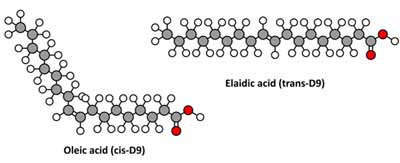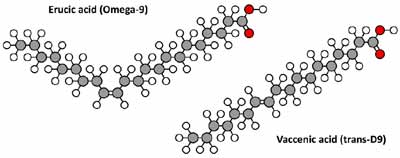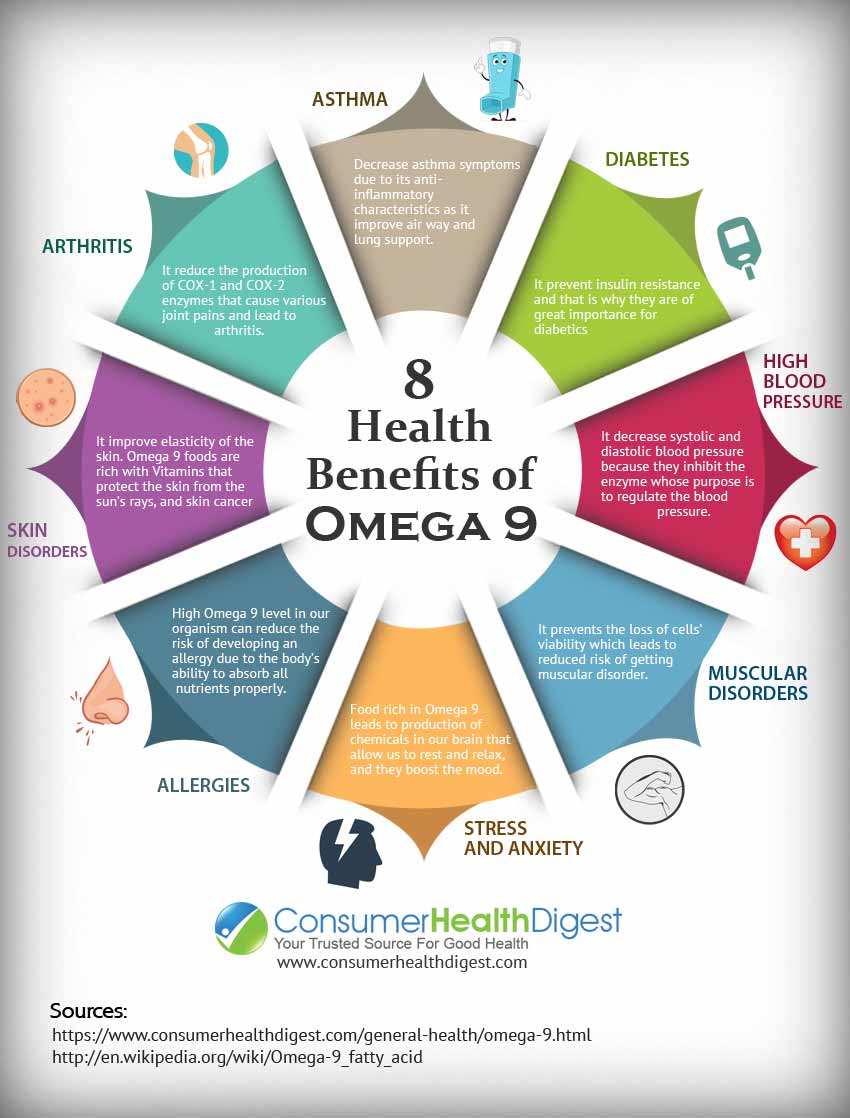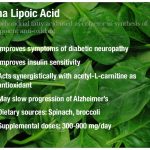Omega 9: Types, Sources, Health Benefits, Side Effects, FAQs & More
Contents
What is Omega 9?
When it comes to Omega 9, they are not as discussed and researched as Omega 3 and Omega 6 fatty acids. Therefore, all definitions are based on a certain amount of researches that were conducted about this type of fatty acids.
Omega 9 fatty acids are included in animal fat and vegetable oil, and they are one of the most important sources of Omega 9. Omega 9 fatty acid belongs to monounsaturated group of fats. It is also known as oleic acid.
Monounsaturated fatty acid is in fact unsaturated acid which has double or triple valence per molecule on their carbon chain. Unsaturated acid is the type of acid whose carbon chain is able to absorb additional atoms of hydrogen.
However, Omega 9 is not one of the crucial fatty acids. The reason why it’s not the crucial fatty acid is in the fact that our body is able to produce it in very small quantities. In order to produce Omega 9 fatty acid, our body needs Omega-3 and Omega-6 fatty acids. If we don’t have a certain level of these fatty acids in our body, then we are unable to produce Omega 9.
Lack of Omega 9 fatty acid’s effects are:
- Pain in joints, or stiffed joints
- Eczema skin eruptions
- Increased urge for eating fatty foods
- Bumps on arms and back
- Irregular heart beat
- Fingertips start to peel or crack
- Miscarriage – one of the most severe effects of Omega 9 deficiency in the body
- Dandruff
- Dry eyes
- Dry hair
- Dry skin – due to the lack of much-needed oils and fat in the body
- Changes in the behavior and mood swings
- Growth retardation
- Dry glands
- Male sterility.
Even though Omega 9 is highly important component to every body, it is not essential and it is less significant than Omega-3 and Omega-6. Additionally, Omega 9 is the most plentiful fatty acid on the planet.
Omega 9 is usually consumed when there is a shortage of Omega-3 or Omega-6 in the body.
The difference between Omega-3, Omega-6, and Omega 9 is in the fact that the first two fatty acids are both polyunsaturated, while Omega 9 is (like we have already mentioned it) monounsaturated, but they can also be polyunsaturated too (mead acid).
What are the Types of Omega 9 Fats?
Omega 9 includes several types of fats. However, there are four of them which are the most important and they are: oleic acid, mead acid, erucic acid and nervonic acid. Other types of Omega 9 fats include elaidic acid and gondoic acid. Below, you can see a detailed analysis of Omega 9’s fats.
1. Oleic Acid

Oleic acid is monounsaturated fat and it is usually found in olive oil. Oleic acid is widely used in cosmetic industry. It is liquid, oil and has no color. This type of fat occurs as glyceride. Oleic acid occurs naturally in animal and vegetable oils and fats.
Formula for oleic acid is CH3(CH2)7CH=CH(CH2)7COOH.
The term oleic means related to or comes from olive oil. Oleic acid is one of the most important components of olive oil.
Oleic acid does not occur in our body by itself and it is not a natural part of it. This type of fat occurs as triglyceride that is one of the ingredients of some types of natural oil.
Olive oil is consisted of oleic acid’s triglycerides. This acid is the most plentiful fatty acid in human’s body fat. This fatty acid is included in our diet, but also it is an important ingredient for producing soaps due to its emulsifying effect.
2. Mead Acid
Mead acid is polyunsaturated fatty acid and it is beneficial for anti-inflammatory purposes by oxidation of unsaturated fats. It was named by James F. Mead who was the first one to recognize, categorize, and describe it.
Formula for mead acid is C20H34O2.
Mead fatty acid is carboxylic acid with three methylene-interrupted cis double bonds and 20-carbon chain.
3. Erucic Acid

Erucic acid is monounsaturated, just like oleic acid. Its name derives from the word Eruca which literally means a plant with a flower.
Formula of erucic acid is CH3(CH2)7CH=CH(CH2)11COOH.
Erucic acid is found in the seed of wallflower. This fatty acid has many uses as mineral oils, because it is more biodegradable than others, plus it is possible to polymerize it and dry for usage in oil paints.
Erucic acid doesn’t have negative effects on human beings; at least the negative effects have never been recorded.
4. Nervonic Acid
Nervonic acid is also monounsaturated fat. It is beneficial for proper brain functions. Nervonic fatty acid is one of the most important components of myelin’s biosynthesis and it is usually found in a white matter of our brains.
Formula of nervonic acid is C24H46O2.
King salmon, the seed of yellow mustard, flaxseed, sockeye salmon, sesame seed and macadamia nuts, are all sources of nervonic acid.
Nervonic acid is beneficial for treatment of demyelination-related disorders like adrenoleukodystrophy (ALD or bronze Schilder disease) and multiple sclerosis which occurs with decreased level of nervonic acid in sphingolipids.
5. Elaidic Acid
Elaidic acid is monounsaturated fat. It is trans isomer of oleic acid and can be found in some meats and vegetable oils. Also, this type of fatty acids is used in the cosmetics industry as well, usually for making lotions.
Formula of elaidic acid is C18H34O2.
The benefit of the elaidic acid is the fact it increases plasma CETP that is good for decreasing HDL cholesterol.
6. Gondoic Acid
Gondoic acid is monounsaturated fatty acid and it is usually found in nuts and plant oils. It is one of the components of rape oil and fish oil and occurs as glyceride. Additionally, gondoic acid can be found in other plant oils like false flax and swede.
The formula of gondoic acid is C20H38O2.
What are the Sources of Omega 9 Fats?

The primary source of Omega 9 is olive oil. However, if we are talking about the general division, there are two sources of Omega 9 fats: animal and fruit/vegetable sources. Further, we will describe both of them.
It must be remembered that all Omega 9 rich foods are healthiest when they are not cooked.
1. Animal Sources of Omega 9 Fats
Even though Omega 9 is usually found in vegetables, plants and fruits, its presence is noticeable in meats of all animals, king salmon, and sockeye salmon and other fish. It is important to remember that fish are a great source of all omega fatty acids.
2. Fruit/Vegetable Sources of Omega 9 Fats
Omega 9 is usually found in nuts, fruits and oils.
| Nuts: | Fruits: | Oils: |
| Almonds | Avocados | Canola |
| Cashews | Olives | Olive oil |
| Macadamias | Peanut oil | |
| Peanuts | Safflower | |
| Pecans | Sunflower | |
| Sunflower | Chia seed oil | |
| Walnuts | Sesame oil |
Also, peanut butter is a great source of Omega 9, as well. It is important to mention that these oils are healthier and more functional than regular cooking oils.
Omega 9 is also found in pumpkin seeds, green leafy vegetables, and grains.
What are the Omega 9 Health Benefits?
Omega 9 fatty acids have a lot of health benefits. Numerous researches have been conducted and they all show that Omega 9 can prevent metabolic syndromes and risk of getting cardiovascular disease.
Omega 9 fatty acids increase HDL cholesterol and decrease LDL cholesterol they reduce the risk of heart attack and stroke.
Health benefits of Omega 9 are:
- Help with Asthma
- Help with diabetes
- Beneficial for arthritis
- Beneficial for osteoporosis
- Can reduce the risk of getting various cancers
- Help with skin disorders
- Help with high cholesterol
- Help with high blood pressure
- Treats muscular disorders
- Helpful for digestive difficulties
Also, Omega 9 can improve one’s immunity, reduce the arteries, reduce the insulin resistance, and also help with stress and anxiety. They are also beneficial for people who are prone to allergies. People with the low level of Omega 9 have a higher risk of gaining an allergy that will cause them problems at some point in their life.
What are the Omega 9 Side Effects?
Omega 9 fat is the most common fat in our bodies. And most of our body fat consists of Omega 9. There are no recorded side effects of Omega 9 fatty acid. The only exception could be erucic acid. Taking too much of erucic acid can lead to a condition called thrombocytopenia that represents a blood clotting problem whose result is the appearance of bruises on the body, even when the person isn’t injured. Also, erucic acid is not good for people who are undergoing chemotherapy because it can lead to heart risks. However, erucic acid is the only exception. Omega 9 fatty acids have no side effects and are beneficial to one’s health.
Also, when it comes to side effects, it is important to mention that Omega-3 and Omega-6 fatty acids have more recorded consequences than Omega 9 due to the fact that Omega 9 is the most abundant acid in our body.
- How Much Omega 9 Should I Get Daily?
First, everyone should bear in mind that consuming daily dosage of Omega 9 gradually during the day is more beneficial than taking entire dosage at once. It is recommended to take one or two tablespoons of extra virgin oil per day. There is no need to take a huge amount of foods and oils rich in Omega 9. One or two tablespoons is enough for the daily intake. - Is it Safe To Take Omega 9 While I’m Pregnant?
Yes. Omega 9 is safe to take during pregnancy but it is recommended to consult the doctor regarding dosage. - Is Omega 9 For Adults Only?
Due to its numerous health benefits, it is recommended for every adult to regularly take Omega 9 fatty acids. They prevent and fight a lot of different disorders and diseases, even ADHD, anorexia, eye diseases, menopausal symptoms,premenstrual syndrome, acne, alcoholism, help losing weight, reduce the risk of cancers, ulcers, heart diseases andtuberculosis. - Is Omega-9 Fat Good For Children?
Omega 9 fats offer a lot of benefits for children and are of extreme importance for the health of the heart and blood sugar control. They are provided through olives, canola oil, avocados or nuts. If a child has a regular intake of the mentioned ingredients, then Omega 9 supplements aren’t needed. - Why is Too Much Omega 9 Detrimental To Health?
Omega 9 is important to the health of skin, coat, joints, and other body systems. However, taking too much Omega 9 on a daily basis can cause a weight gain. Some athletes in order to gain more weight and mass take Omega 9 supplements. Also, like it was stated before, erucic acids can cause certain disorders and conditions, but the right dosage and careful intake of ingredients that contain erucic acid will not cause any harm. - Is it Safe To Take Omega 9 Without Consulting A Doctor? Do I Need A Prescription To Take Omega 9 Oils?
Yes. It is completely safe to take Omega 9 without a doctor and you do not need a prescription in order to take Omega 9 oils. It is recommended, though, to consult your doctor, explain why you want to take Omega 9 and ask for their opinion.
Conclusion
Like all Omega fatty acids, Omega 9 fatty acid has its own benefits. The most beneficial component is the oleic acid. Also, one doesn’t need any additional supplements. It is enough to take fruits, seeds, and meats rich in Omega 9. It is important to remember that Omega 9 is the most common fatty acid in our body.
The bottom line is, regardless of the significance of each fatty acid (Omega-3, Omega-6, or Omega 9), having adequate body functions and in order for all of them to operate in the best possible way, they all need to cooperate. That is why in order to have enough Omega 9, one must also have a significant level of Omega-3 and Omega-6 fatty acids.
Our bodies are all about the balance. The balance is needed for optimal performance of all our body’s components. Buying Omega 9 supplements is not necessary because this fatty acid is not essential due to our body’s ability to create it. If you are not sure whether to take Omega 9 supplements or not, just consult your doctor and ask for their advice.
References:
- Dolecek, T.A. “Epidemiological evidence of relationships between dietary polyunsaturated fatty acids and mortality in the Multiple Risk Factor Intervention Trial.” PSEBM.
- Lands, William E.M. (December 2005). “Dietary fat and health: the evidence and the politics of prevention: careful use of dietary fats can improve life and prevent disease.” Annals of the New York Academy of Sciences 1055: 179-192. Blackwell. doi:10.1196/annals.
- Holman RT. George O. Burr and the discovery of essential fatty acids. J Nutr.
- Burr GO, Burr MM. On the Nature and Role of the Fatty Acids Essential in Nutrition. J Biol Chem.
https://www.consumerhealthdigest.com/general-health/omega-9.html






